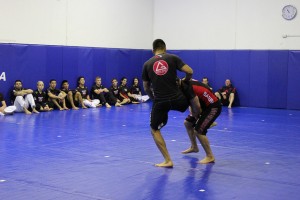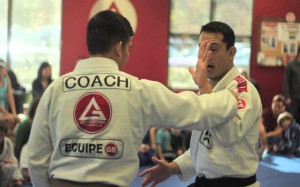The Biggest Debates in Brazilian Jiu-jitsu
Whether it takes place around the mat at the academy or on popular internet message boards devoted to all topics bjj, discussions on certain subjects invite some spirited debates. As with all subjects with no clear cut truth, the arguments on both sides of the question have their adherents, each side with valid points to support their arguments.
These topics surface time and time again in bjj academies around the world in every language.
1) Gi vs. no-gi training
Traditional bjj is taught in the kimono the way the Gracie family has done it for decades. MMA fighters and those who prefer training without the gi think this is old fashioned thinking.
Both sides of this argument have solid points:
 Gi: The majority of the gold medals in top level grappling competitions are taken home by competitors who train primarily in the gi. They posit that training in the kimono makes you more technical than training without.
Gi: The majority of the gold medals in top level grappling competitions are taken home by competitors who train primarily in the gi. They posit that training in the kimono makes you more technical than training without.
No-gi: Why waste so much training time working on grips that completely disappear once the kimono is removed? They say that it is only a matter of time until the no-gi specialists dominate the submission grappling competitions like ADCC.
2) Self defense training vs. sports bjj
Two schools of philosophy on the application of bjj:
 Self defense: Most students begin their training in bjj for the purpose of personal self defense. To focus on techniques that ignore the threat of strikes is moving away from the purpose of jiu-jitsu as first and foremost a martial art for real fighting. Keep it real!
Self defense: Most students begin their training in bjj for the purpose of personal self defense. To focus on techniques that ignore the threat of strikes is moving away from the purpose of jiu-jitsu as first and foremost a martial art for real fighting. Keep it real!
Sports bjj: Most people never have a street fight in their entire adult lives, so what is the point of years of training for something that might never happen? Bjj is about staying fit and having fun learning the art. A purple belt is more than capable of handing any potential street fracas.
3) Old school game vs. berimbolo, worm guard, 50/50 guard etc.
Has the modern evolution of sports bjj specialty techniques gone too far and become no longer effective for real fighting?
 Old school: No less an authority than Master Carlos Gracie Jr, expressed his preference for a jiu-jitsu based on the fundamental positions that all practitioners can use effectively – regardless of age. The fundamental positions of mount, guard and back mount will never cease to be effective.
Old school: No less an authority than Master Carlos Gracie Jr, expressed his preference for a jiu-jitsu based on the fundamental positions that all practitioners can use effectively – regardless of age. The fundamental positions of mount, guard and back mount will never cease to be effective.
New school: No art or sport can remain static and resist innovation. The evolution of the techniques and positions is continuous so that the art doesn’t deteriorate into losing its effectiveness. Bjj practitioners must strive to keep up with the latest advances being introduced by the sports elite or risk being left behind.
4) Bjj as business vs Traditional Martial Arts
Bjj as introduced outside of the original academies (in North America especially) has evolved to more of a fitness business model compared to the old model of the Japanese dojo.
 Bjj as business: As the students are often paying top dollar for quality black belt instruction, many new students view the academy as more of a service they are paying for. The older concepts of sweeping the dojo / helping clean the mats as part of your duties is eroding and students expect to show up for class and have a professionally run experience.
Bjj as business: As the students are often paying top dollar for quality black belt instruction, many new students view the academy as more of a service they are paying for. The older concepts of sweeping the dojo / helping clean the mats as part of your duties is eroding and students expect to show up for class and have a professionally run experience.
Traditional Martial Arts: Some feel that something is lost with the diminishing of the dojo as a center where it was seen as more than a fitness gym by the students and instructors. Not only physical training, but philosophical and ethical teaching was part of the student’s instruction. Formalities such as bowing and calling the instructor Sensei are seen to be important matters of respect and continuance of these traditions.
5) Creonte / loyalty to one school vs. Train everywhere
This controversy is alive and well in the bjj subculture
 Old school: “Creonte” was a negative term coined by Carlson Gracie Sr. (loosely translated to mean “traitor”) to describe students who left their home academy to train with another team. In an era before YouTube, a school’s signature techniques were considered closely guarded secrets and meant to be kept within the walls of the academy. You picked your team and you stayed loyal to that team over the years of your bjj career. The relationship between professor and student is seen as greater than simply a student purchasing classes at a fitness gym. Loyalty is highly prized as a value between the teacher and students.
Old school: “Creonte” was a negative term coined by Carlson Gracie Sr. (loosely translated to mean “traitor”) to describe students who left their home academy to train with another team. In an era before YouTube, a school’s signature techniques were considered closely guarded secrets and meant to be kept within the walls of the academy. You picked your team and you stayed loyal to that team over the years of your bjj career. The relationship between professor and student is seen as greater than simply a student purchasing classes at a fitness gym. Loyalty is highly prized as a value between the teacher and students.
Train everywhere: Some top instructors famously have said that their philosophy is “Train with everyone.” At this point in bjj history, we are experiencing an unprecedented explosion of knowledge and ability to share bjj techniques with each other all over the world. There are fewer true secret techniques anymore. There is a movement towards more open philosophy of sharing techniques but also visiting friends at other academies and training at other schools. The exchange of knowledge can only be seen as a positive for the development and spread of jiu-jitsu.
Where do you stand on these controversies in jiu-jitsu?
Credits: Mark Mullen
Gracie Barra Black belt based in Taipei, Taiwan
Twitter: @MarkMullenBJJ

